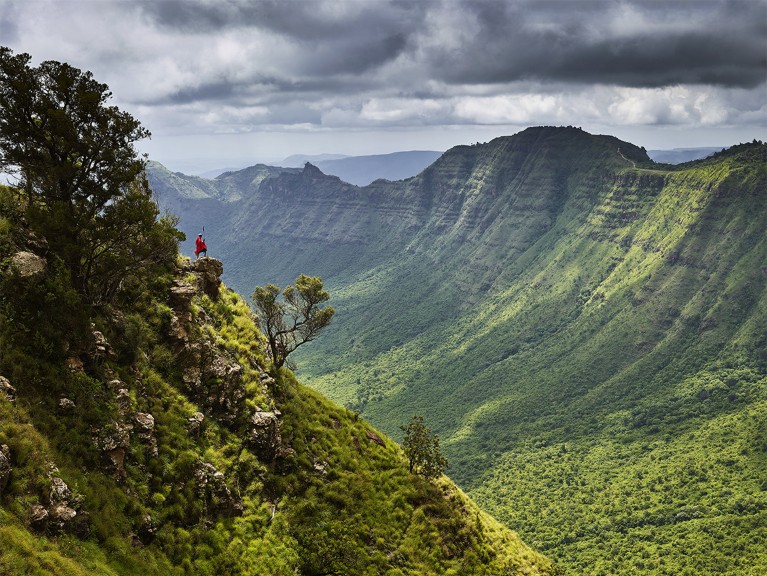Origins: How The Earth Made Us Lewis Dartnell The Bodley Head (2019)
In this age of worldwide climatic deterioration, many authors have documented what we are doing to our planet. Lewis Dartnell turns the tables in his book Origins. He asks how Earth has affected us, through our long evolution to big brains, small jaws and scrawny bodies that somehow cooperate with each other enough to make us the planet’s dominant eukaryotic species. All this began, Dartnell argues, with the tectonic processes that created the East African Rift — the area that today runs from Somalia and Ethiopia down to the coast of Mozambique. The uplift of mountains here caused a rain shadow that dried and warmed East Africa, turned jungle into a park-like savannah, and enticed early hominins to leave the trees and become game hunters, runners, thinkers, cooks and, eventually, empire builders.
The steps of this long, Earth-changing process are both generalizable and repeatable. Tectonic events push up vast sections of land, and these upraised rocks are then eroded, leading to nutrients and minerals being transported down to lower elevations, nurturing the development of agriculture in civilizations on various continents. In the same way, mountain ranges provide the headwaters for rivers such as the Nile, the Tigris and the Euphrates, allowing agriculture to prosper reliably in otherwise barren regions. We are tied to tectonics more than we admit, Dartnell argues.
But regional tectonic events alone can’t account for fluctuations in worldwide temperature and moisture patterns over many tens of millions of years. Behind these is a complex system of vacillating astrophysical influences that include the eccentricity and shape of Earth’s orbit, the tilt of its axis and the movements of the Sun. Even more complexity comes from one-time events, such as the collapse of the giant Lake Agassiz in Canada some 13,000 years ago, which caused water to drain into oceans, raised sea levels, stymied ocean circulation, changed climates half a planet away and might have frustrated nascent agriculture in the Middle East.
Deep time has a role, too. Subsurface pressure and temperature effects cause changes in the composition and properties of rocks, and from these we reap flint, chert, loess, kaolin, granite and clay. Most industrial iron today comes from banded iron formations, which mainly formed in the Precambrian era (600 million years ago and earlier). And environmental changes, including cooling and drying, on the plains and steppes of the world tens of millions of years ago provided opportunities for the evolution of grasses, horses and camels, all of which have been indispensable to humans. On a shorter timescale, the primacy of wood exploitation (where timber was available or could be traded for) gave way to the ages of bronze and then iron, as technology evolved to take advantage of copper and tin and to forge steel. Trade developed on both sea and land, and its corollaries ranged from cultural exchange to wars, all conditioned by geography and climate.
Such a grand sweep of history and prehistory could be chaotic, but Dartnell’s story is beautifully written and organized. His infectious curiosity and enthusiasm tug the reader from page to page, synthesizing geology, oceanography, climatology, meteorology, geography, palaeontology, archaeology and political history in a manner that recalls Jared Diamond’s classic 1997 book Guns, Germs, and Steel. Ever surprising, Dartnell juxtaposes facts as different as the sources of stone for the pyramids and the natural geographic divisions that separate Eastern Orthodox, Roman Catholic and Protestant Christianity.
This engaging treatment holds a larger lesson. In public education, the planetary sciences (geology, geography, climatology and astronomy) usually take a back seat to the more reductionist aspects of chemistry, physics and biology — at least in the United States. Here, ‘rocks for jocks’ — Earth science — is often taught by the football coach, and populated by students who, it is thought, ‘can’t handle’ the other sciences. All the sciences are important. But only an acquaintance with Earth science allows people to understand whether there is a risk in building their houses on the Russian River floodplain in California or an eroding cliff in Goa, India; how the sediment under a house might withstand a magnitude-8.0 earthquake; whether the aquifers in a valley’s hills are sufficient to sustain a golf course; and whether its soils can support plant communities that won’t turn into a fatal tinderbox during dry years of a climatic cycle. In our current geopolitical climate, this knowledge is more important than ever.


 The past, present and future of human evolution
The past, present and future of human evolution
 Pursuing the primordial
Pursuing the primordial
 Human evolution: Just add water
Human evolution: Just add water






